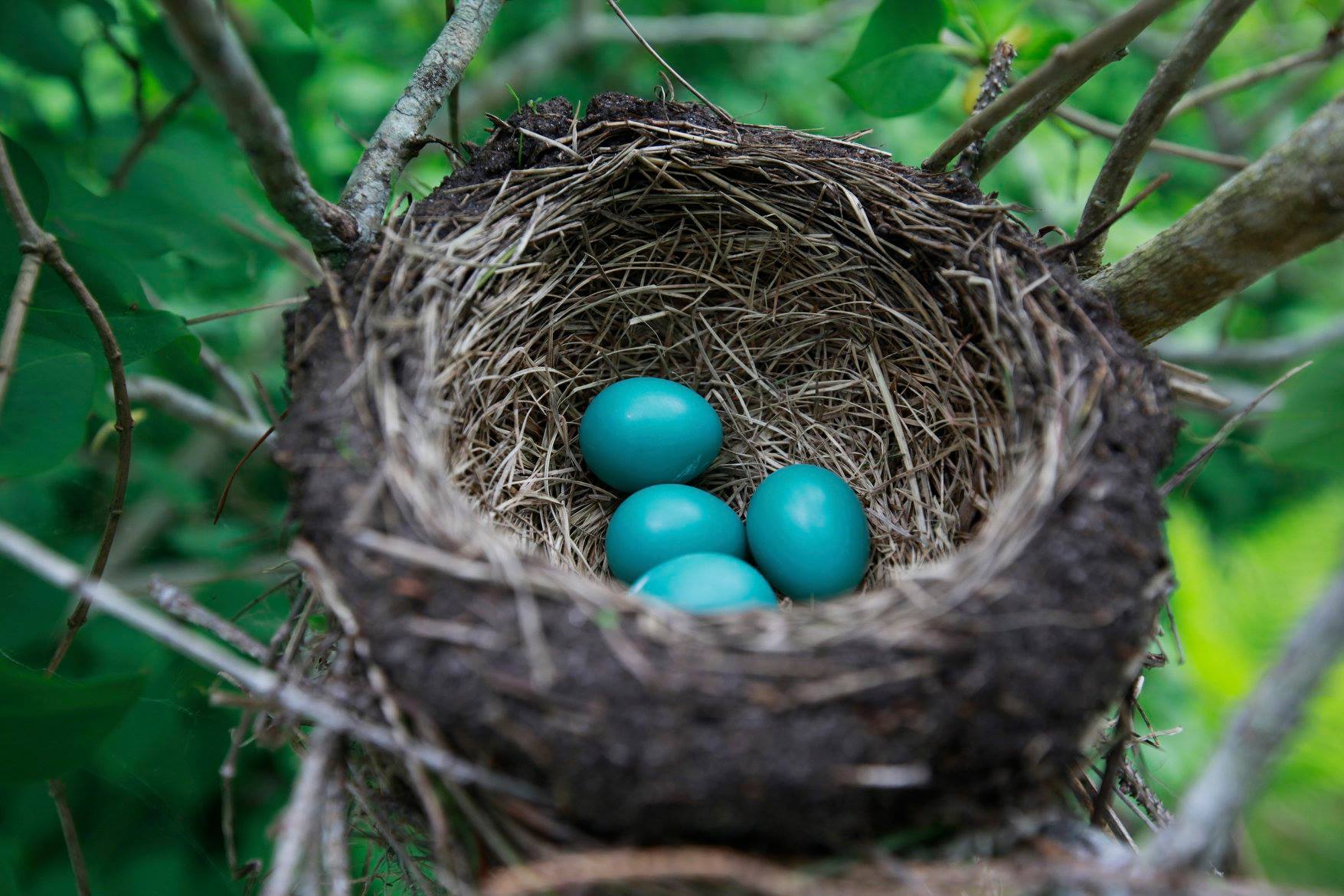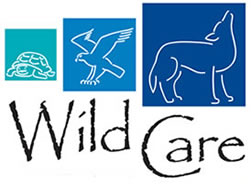
Migratory Bird Treaty Act: What is it, and Why is it Important?
Adventures of a Volunteer, By Amy Sanders
American Robin nest. Photo by Leo Seletsky
It’s been another quiet month for this volunteer, at least in terms of crazy stories. I did pilot a new talk based on my previously written about stories, fed baby birds, and did quite a bit of communications, but none of these activities make a fun story, so when I queried what I might write about this month, the Migratory Bird Treaty Act of 1918, and its implications, was suggested. It’s come up in a variety of situations this month so it was high on many of our minds.
First of all, in context it’s often referred to by Wild Care, and other wildlife rehabbers as the MBTA, which can make many of us scratch our heads wondering what Boston’s transportation system has to do with anything. So, it might help you to keep in mind the context when you hear MBTA in any wildlife conversation. It has absolutely nothing to do with transportation in Boston!
So, what exactly is this treaty? Stated simply, it’s a treaty signed amongst several countries to protect migratory birds from exploitation by people. It is currently federal law in the US, Canada, Mexico, Japan and Russia. From the USFWS: “The MBTA provides that it is unlawful to pursue, hunt, take, capture, kill, possess, sell, purchase, barter, import, export, or transport any migratory bird, or any part, nest, or egg or any such bird, unless authorized under a permit issued by the Secretary of the Interior.”3
It has been updated several times. In 1962 an amendment was added to clarify how bird feathers might be used by Native Americans in tribal ceremonies. In 1972 hawks and eagles were added to the list. Then in 2004 another update clarified that the law did not apply to non-native (or invasive) species. Finally, in 2020, the list of protected birds was updated and expanded to include newly developed species and organize the list according to newer scientific understandings about bird classifications. It now covers over 1000 species of birds.2,3
The MBTA has been critical in saving the Snowy Egret after being hunted to near extinction. It’s also saved the Sandhill Crane and Wood Duck, both of which were also nearing extinction.2 It brought a 100 million dollar settlement to help restore habitats from the BP Gulf of Mexico oil spill in 2010.4
There are several reasons this law has popped up lately for Wild Care.
First, note that it is illegal to possess a bird’s nest. This became an issue this month when I transported a small baby bird that had been placed in saved bird’s nest (from another type of bird), and I unknowingly promised the return of the nest. It is not legal to possess a nest of a migratory bird, even if you found the nest empty. Who knew that!? Wild Care can keep a found nest if it’s used for educational purposes, by a special federal “Salvage Permit”, and must report on any nests they retain, but the rest of us should not have them. My guess is that the gist of this is to prevent people from collecting a nest being used for the purpose of a cool souvenir, and also to prevent the spread of some avian parasites that could potentially be present in a nest.
Not specific to this month, but important, is that this law is the impetus for electrical companies to work with wildlife organizations to protect birds that nest on high power lines (such as ospreys). Depending on where you live, you may have noticed the construction of nesting poles to encourage nesting in places other than electrical poles, as well as the installation of annoying wires or spikes on top of poles carrying high voltage to discourage nesting on them. Even with those cautions in place, some ospreys still fall victim to electrocution though, so more work is needed in this area. Wild Care has a representative (Wild Care’s Executive Director) working in a Cape-wide group working to address this problem.
In the last few months, queries have been made by several folks, as well as myself, about land clearing for new construction. This is a work in progress in terms of research, but what I have found so far is that on the Cape, a construction project is subject to a conservation review, not only for the MBTA, but also for MESA (Massachusetts Endangered Species Act) if the project is within what is called “Priority Habitat of State-listed Species1.” I have determined, however, that this process is a very slow one. Communication alone on this can take months, and I have yet to determine who is “in charge” of seeing that this is followed. The construction project in question for me, which was in a “Priority Habitat” was cleared while I was researching this (I do not know, however, that they did not have that review completed). So, more work is obviously needed in this area too, to allow all of us in the public to better understand how we might protect wildlife in such circumstances.
When it comes to standard yard maintenance, we like to remind folks all the time that tree clearing is best left to the off season. Many folks have spring cleaning done by local landscapers and unknowingly damage and/or destroy nests not only for migratory birds, but also for non-migratory birds and squirrels. We get many, many babies who would be best raised by their mothers because of clearing.
We’d also like to note, that when it comes to moving a nest of baby birds that happens to be in an inconvenient place, that not only is it illegal to do so, but that most of the eggs in these nests will incubate and fledge in under a month. It’s not a terrible ask for our feathered friends, to allow one month for eggs to incubate, hatch and fledge – and then make that area less attractive for nesting in the future. If you would like assistance in how to do that, give us a call. We are happy to help, but please let established nests (with eggs) alone until after fledging.
One more note on the MBTA: It is almost always in danger from those who prefer business interests over those of conservation. The recent Trump administration interpretation, for example, allowed “incidental” taking of birds, nests and feathers. Thus, if a company’s power lines were electrocuting birds but the company didn’t set out to purposely kill those birds and instead just allowed it to happen, they would not be in violation of the treaty. If an oil spill occurred, the company transporting the oil could not be held accountable for the migratory bird loss. This change in interpretation made legal the killing of up to 72 million birds per year with no accountability to at least attempt to resolve the problems (estimated high voltage, communication towers, oil spills and wind turbine deaths combined).
Yet there are solutions that just can potentially cost a small amount of money. UV lights and reflective paint, noise makers at frequencies birds are sensitive to, and use of radar to monitor migrating birds are all possible ways to alleviate strikes by wind turbines. Nest deterrents for high voltage and communication tower and regulations for double hulling on oil transport ships have all proven effective in reducing environmental impacts of businesses. There are also many other possible options being researched.4.1-4.2
The Biden administration has fortunately reversed the Trump administration’s interpretation change, restoring the teeth of the Migratory Bird Treaty Act.4.3 If we all do our part to encourage bird friendly regulations, we can do a lot as consumers to help our feathered friends.
Resources (and to read more about this treaty):
- Massachusetts Fish & Wildlife Service website:
- mass.gov/nhesp (Natural Heritage & Endangered Species Program)
- https://www.mass.gov/service-details/regulatory-maps-priority-estimated-habitats (Map of Cape Cod Priority Habitats)
- National Audubon Society website:
- US Fish & Wildlife Service websites:
- https://www.fws.gov/laws/lawsdigest/migtrea.html
- https://fws.gov/birds/policies-and-regulations/laws-legislations/migratory-bird-treaty-act.php
- Other:
- https://greentumble.com/how-to-prevent-birds-from-running-into-operating-wind-turbines/#:~:text=Technology%20can%20also%20play%20a%20role%20in%20protecting,maps%20online%20of%20migration%20forecasts%20and%20real-time%20movement.
- https://www.treehugger.com/ways-to-protect-bats-and-birds-from-wind-turbines-4868663
- https://www.courthousenews.com/biden-reverses-trump-era-gut-of-migratory-bird-protections/
Wild Night Out Online Auction
READY, SET, BID… We are so excited to announce that our Wild Night Out Online Auction is now live!
READ ALL NEWS
CALENDAR OF EVENTS
04 April, 2024
Wild Night Out Online Auction
EVENT DETAILS
05 April, 2024
Wild Night Out
EVENT DETAILS
28 February, 2024
Wildlife Winter/Spring Talk Series
EVENT DETAILS

DID YOU KNOW??
Wild Care has a state-of-the-art seabird therapy pool, which allows seabirds and waterfowl to exercise on running water. This will help our bird friends recover more quickly so they can get back to their watery habitats!

